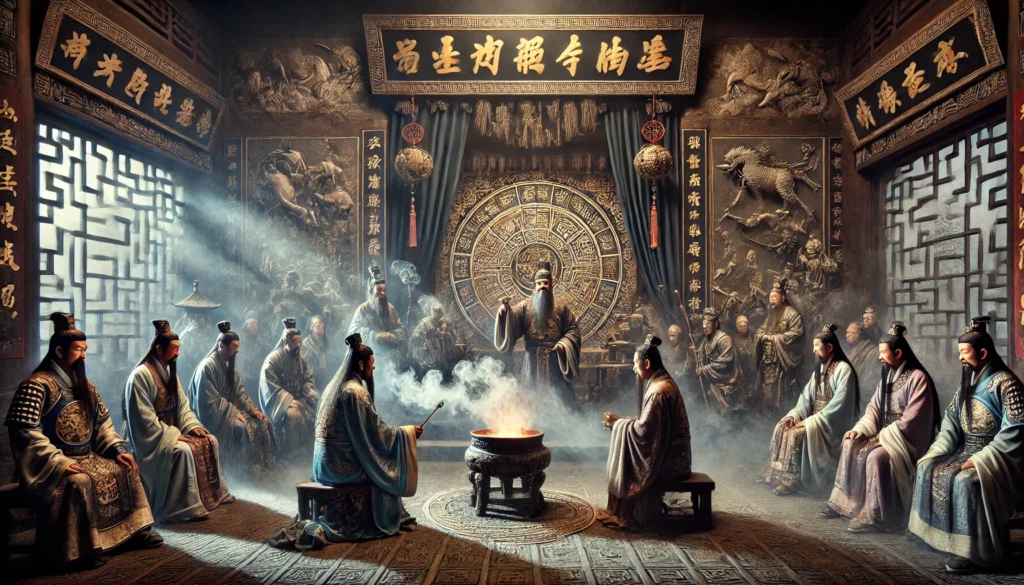The history of curses and curseology in ancient China, particularly during the Zhou Dynasty (1046–256 BCE), reveals a rich tapestry of beliefs in supernatural forces, rituals, and protections against malevolent intentions. Curse practices in this period were closely intertwined with the spiritual and political life of the society, showing how curses were used for both personal protection and, at times, as tools for political control.
1. Spiritual Beliefs and Ancestor Worship
- Ancestor Worship: Zhou society had a strong belief in ancestor spirits and the spiritual world. People believed that ancestors could influence the living world, either helping or harming them based on familial piety. Curses often sought protection from the wrath of neglected or angered ancestors.
- Tian (Heaven) and Mandate of Heaven: The Zhou introduced the concept of the Mandate of Heaven (天命, Tiānmìng), which justified the emperor’s rule as a divine mandate. This belief included the notion that curses and calamities could be signs of divine disfavor. An emperor who lost Heaven’s mandate was vulnerable to curses, seen as natural punishments from the heavens.
2. Use of Writings and Talismans in Curses
- Written Curses and Symbols: Early forms of written curses began appearing, where inscriptions or symbols were used to invoke supernatural forces. Writings would often call upon spirits or deities to punish or harm enemies or unfaithful individuals.
- Talismans: Bronze inscriptions and jade carvings were used to inscribe protective prayers or curses against evil forces. These objects could be carried or placed in specific locations to ward off evil, much like protective amulets. Zhou talismans were believed to contain power when activated by proper rituals.
3. Rituals of Protection and Cursing
- Exorcism Rituals: Exorcisms were common practices that included chanting, incense, and sometimes the use of specific plants or herbs. These rituals sought to expel malevolent forces or undo curses placed by others.
- Cursing Rituals: Some rituals were specifically designed to curse enemies or rivals. Such rituals might involve burning symbolic objects representing the target or chanting incantations that called upon deities to bring misfortune or illness to them. Shamans or spiritual intermediaries would often conduct these rituals, and they were sometimes employed by nobility to target political rivals.
4. Role of Shamans and Wu (巫)
- Wu (Shamanistic Figures): Shamans, or “Wu” (巫), played a central role in mediating between the human and spiritual realms. They were consulted for curses and protections, particularly by those in positions of power, including kings and nobles. Wu could perform rituals to invoke curses on enemies, cleanse curses from afflicted individuals, or provide amulets and talismans for ongoing protection.
- Divination and Oracles: The Zhou used divination practices, such as bone oracles and turtle shell readings, to foresee the influence of curses or to detect the presence of malicious spirits. Oracles would guide decisions about curse rituals or protection strategies and were taken as serious insights into the future and the spirit world.
5. Political Use of Curses
- Curse as a Political Tool: The rulers of the Zhou Dynasty used curses, both real and symbolic, to assert power over vassals and maintain control. Cursing enemies or publicly declaring curses upon rebels was one way to show that the rulers were favored by the divine and that rebellion was against the will of Heaven.
- Protective Curses for Burial and Tombs: Tomb curses began to appear, warning trespassers or grave robbers of supernatural consequences should they disturb the tombs. These curses were meant to protect the deceased and their belongings, often inscribed on tomb walls or burial objects.
6. Texts and Documents on Curses
- The Book of Changes (I Ching): While not directly a curse text, the I Ching (易经) was used for divination, helping people understand whether they were under a curse or in need of protection. The text provided a framework for understanding fate and cosmic balance, hinting that disturbances (such as curses) could be read and remedied.
- Bronze Inscriptions and Curse Warnings: Inscriptions on bronze artifacts from the Zhou period sometimes included warnings or invocations aimed at securing divine protection, which could functionally work as curses against those who sought to harm the artifact’s owner.
Curses in Zhou society were thus a blend of spiritual belief, political tool, and personal protection mechanism. They reveal how intertwined the supernatural and social order were in ancient China, with curseology providing a means for individuals to seek control over their lives within the rigid hierarchical structures of Zhou society.
